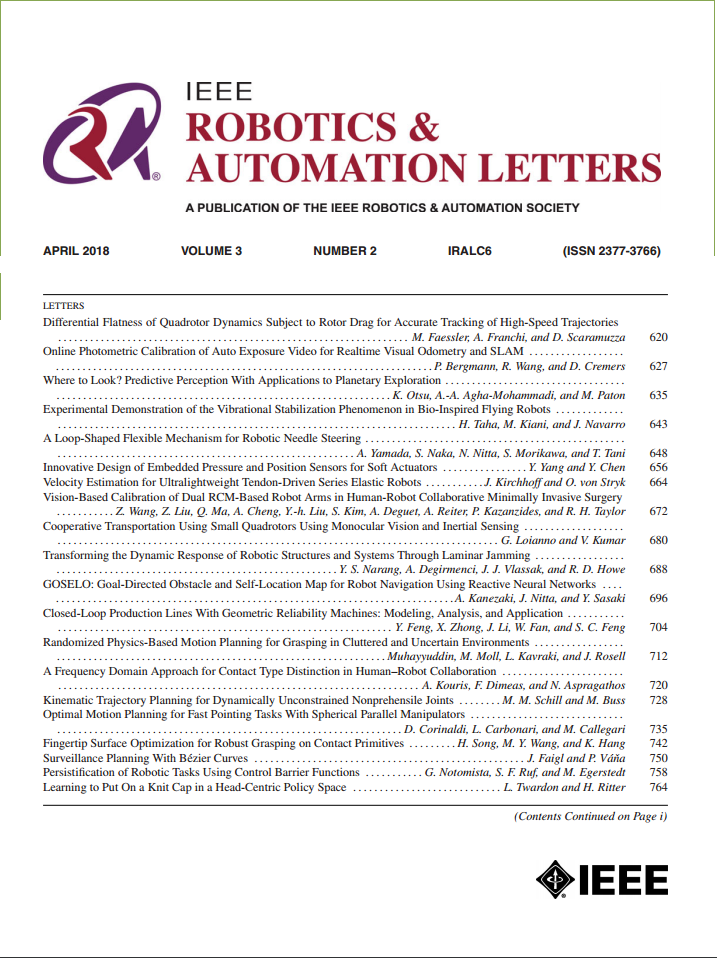基于gan合成图像的水下特征提取与匹配的知识蒸馏
IF 5.3
2区 计算机科学
Q2 ROBOTICS
引用次数: 0
摘要
自主水下航行器(auv)在水下探测中起着至关重要的作用。在没有GPS和激光雷达等传统传感器的情况下,基于视觉的方法为定位和测绘提供了经济有效的解决方案。然而,水下环境由于衰减、散射和海洋雪的干扰导致图像模糊和噪声,对特征提取和匹配提出了重大挑战。本文以合成的水下图像为介质,采用跨模态知识蒸馏方法,将空气中的特征提取与匹配模型转移到水下环境中,以提高浑浊水下环境中特征提取与匹配的鲁棒性。我们首先提出了一种新的自适应gan合成方法来估计水参数和水下噪声分布,以生成特定环境的合成水下图像。然后,我们引入了一个适用于不同教师模型的通用知识蒸馏框架。对基于gan的合成的评价突出了新成分的重要性,即gan合成的噪声和前向散射,在提出的模型中。此外,将VSLAM作为特征提取与匹配的代表性下游应用,应用于真实水下序列,验证转移模型的有效性。本文章由计算机程序翻译,如有差异,请以英文原文为准。
Knowledge Distillation for Underwater Feature Extraction and Matching via GAN-Synthesized Images
Autonomous Underwater Vehicles (AUVs) play a crucial role in underwater exploration. Vision-based methods offer cost-effective solutions for localization and mapping in the absence of conventional sensors like GPS and LiDAR. However, underwater environments present significant challenges for feature extraction and matching due to image blurring and noise caused by attenuation, scattering, and the interference of marine snow. In this paper, we aim to improve the robustness of the feature extraction and matching in the turbid underwater environment using the cross-modal knowledge distillation method that transfers the in-air feature extraction and matching models to underwater settings using synthetic underwater images as the medium. We first propose a novel adaptive GAN-synthesis method to estimate water parameters and underwater noise distribution, to generate environment-specific synthetic underwater images. We then introduce a general knowledge distillation framework compatible with different teacher models. The evaluation of GAN-based synthesis highlights the significance of the new components, i.e. GAN-synthesized noise and forward scattering, in the proposed model. Additionally, VSLAM, as a representative downstream application of feature extraction and matching, is employed on real underwater sequences to validate the effectiveness of the transferred model.
求助全文
通过发布文献求助,成功后即可免费获取论文全文。
去求助
来源期刊

IEEE Robotics and Automation Letters
Computer Science-Computer Science Applications
CiteScore
9.60
自引率
15.40%
发文量
1428
期刊介绍:
The scope of this journal is to publish peer-reviewed articles that provide a timely and concise account of innovative research ideas and application results, reporting significant theoretical findings and application case studies in areas of robotics and automation.
 求助内容:
求助内容: 应助结果提醒方式:
应助结果提醒方式:


